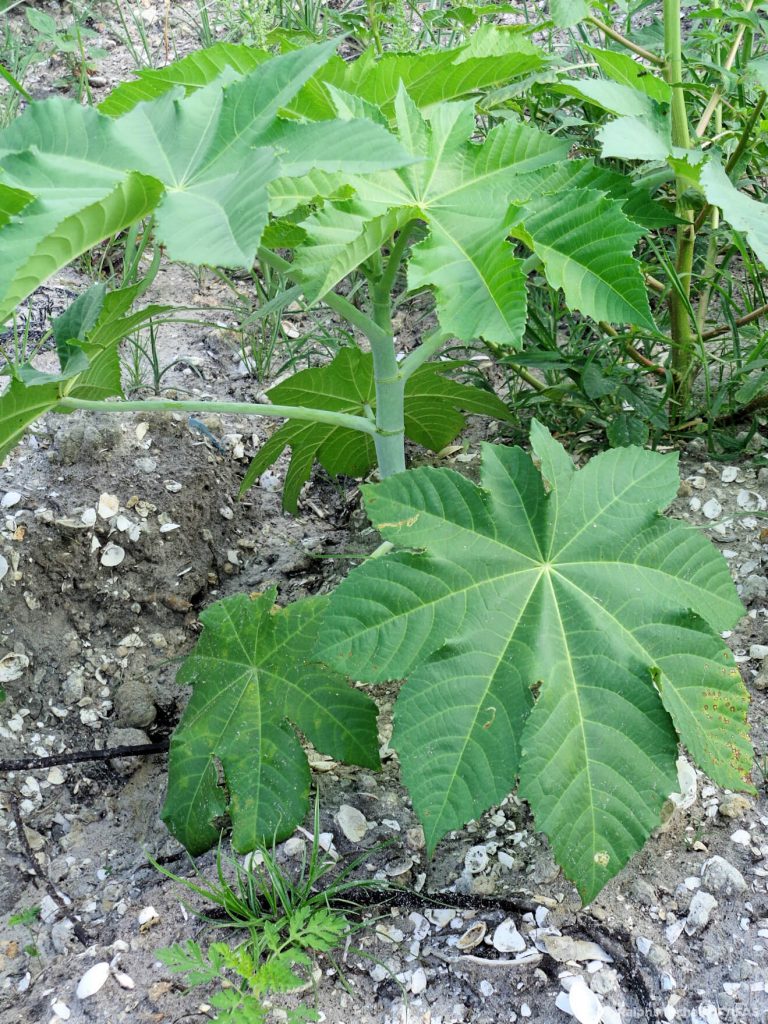
Some plants can be both beautiful and toxic at the same time. This includes the castor bean, Ricinus communis, a common invasive plant. Still commercially grown in some areas of the world for its industrial uses, castor beans have also been a flower garden subject well known as a colorful annual ornamental plant. In either case, the castor bean is an invasive plant, and with its highly toxic nature, is best left alone.
You have probably seen a castor bean plant as an invasive exotic showing up almost anywhere soil is disturbed or fill is moved. Look for these tropical-looking plants on the sides of roads or abandoned sites where soil has been disturbed. Castor beans are sizable plants over fifteen feet tall and often develop in scattered patches. Their broad, palmate, star-like leaves are around two-feet across and green to maroon in color. Flowers spikes form during the summer and fall, and are followed by green, pink, or red spiny seed capsules which turn brown with age. The resulting shiny seeds are mottled brown, gray or reddish in color and look like, and are the size of, ticks. The genus, Ricinus, actually means “tick” in Latin. While castor beans originated in tropical northeastern Africa, they are now found worldwide in tropical and subtropical regions where they are more often than not, a weedy, naturalized plant.
Commercially, castor beans are grown and processed into paint, varnish, oils, soap, ink, plastics, polishes, and lubricants. Processed castor beans have also been used for fertilizer and livestock feeds. Castor oil is well known for its medicinal uses. Perhaps the most infamous part of the castor bean is the highly toxic material known as ricin, a deadly natural poison. Castor bean plants also produces pollen that some people are allergic to. All plant parts can cause skin irritations.
Castor beans are classified as CATEGORY II Invasive plants which means that these are, according to the Florida Exotic Pest Plant Council (FLEPPC) “Invasive exotics that have increased in abundance or frequency but have not yet altered Florida plant communities to the extent shown by Category I species. These species may become ranked Category I if ecological damage is demonstrated.” The UF/IFAS Assessment of Non-native Plants in Florida’s Natural Areas mentions that the castor bean is invasive and not recommended as a landscape plant.
Keep in mind that the castor bean has not been available in Florida nurseries since 2001. Members of the Florida Nursery Grower’s Association actually voted to stop selling this plant. As an ornamental, castor bean seeds are available from seed catalogs. There are many colorful cultivars including ‘Carmencita’ in shades of red, pink and rose-toned stems and seed pods, ‘New Zealand purple’ with purplish leaves, and ‘Zanzibarensis’, with green leaves with white midribs. It goes without saying that these plants should be kept out of the reach of children and pets. Some gardeners prune off the flower heads so that no beans are produced.
So, know the cautions and issues related to the castor bean. Eliminate this invasive plant if you find it on your property. Perhaps rethink the castor bean as an ornamental and steer clear of this exotic – both for its toxic and invasive characteristics. For more information on all types of invasive plants found in our area, or to ask a question, please visit https://www.facebook.com/CharlotteMGLifeline/. Ralph E. Mitchell is the Director/Horticulture Agent for the UF/IFAS Charlotte County Extension Service. He can be reached at 941-764-4344 or ralph.mitchell@charlot tecountyfl.gov.
Resources:
Friedman, M. H., Andreu, M. G., Quintana, H. V. & McKenzie, M. (2019) Ricinus communis, Castor Bean. The University of Florida Extension Service, IFAS.
Mahr, S. (2012) Castor Bean, Ricinus communis. University of Wisconsin-Madison Division of Extension.
FLEPPC 2019 List of Invasive Plant Species – http://bugwoodcloud.org/CDN/fleppc/plantlists/2019/2019_Plant_List_ABSOLUTE_FINAL.pdf.
 2
2
